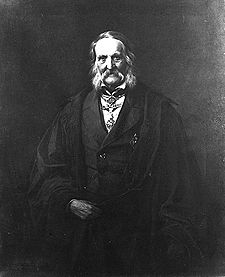Franz Ernst Neumann facts for kids
Quick facts for kids
Franz Ernst Neumann
|
|
|---|---|

Franz Ernst Neumann.
Portrait by Carl Steffeck (1886) |
|
| Born | 11 September 1798 |
| Died | 23 May 1895 (aged 96) |
| Nationality | German |
| Alma mater | University of Berlin |
| Known for | Crystallography Neumann formula Neumann's law Neumann–Minnigerode-Curie principle Kopp–Neumann law Magnetic vector potential |
| Awards | Copley Medal (1886) ForMemRS (1862) Pour le Mérite for Sciences and Arts (1860) |
| Scientific career | |
| Fields | Physics Mineralogy |
| Institutions | Königsberg University |
| Doctoral advisor | Christian Samuel Weiss |
| Doctoral students | Woldemar Voigt Alfred Clebsch Gustav Robert Kirchhoff Friedrich Heinrich Albert Wangerin |
Franz Ernst Neumann (born September 11, 1798 – died May 23, 1895) was an important German mineralogist and physicist. He made many discoveries in the study of crystals, light, and electricity.
Contents
Biography
Early Life and Education
Franz Ernst Neumann was born in Joachimsthal, a town near Berlin. In 1815, when he was 16, he stopped his studies to join the army. He fought as a volunteer against Napoleon during the Hundred Days and was hurt in the Battle of Ligny.
After the war, he went to Berlin University. He first studied theology, which is the study of religion. However, he soon changed his focus to science.
Contributions to Science
Crystallography and Neumann's Law
Neumann's first scientific work was mostly about crystallography. This is the study of how crystals are formed and their properties. His work in this area made him well-known. Because of his reputation, he was invited to teach at the University of Königsberg. He became a professor of mineralogy and physics there in 1829.
In 1831, Neumann studied how much heat different chemical compounds could hold. This led to what is now called Neumann's Law. This law states that the heat capacity of a compound is equal to the sum of the heat capacities of the atoms it's made of.
Understanding Light and Symmetry
Next, Neumann focused on the study of optics, which is about light. He wrote important papers that helped scientists understand light better. In 1832, he used a special idea about how light travels through space (called the "ether"). With careful calculations, he found results that matched other scientists' findings. He also figured out laws for double refraction. This is when light splits into two rays as it passes through certain materials.
When studying double refraction, Neumann used an important idea: the physical properties of a crystal are as symmetrical as its shape. This idea helped simplify complex equations. His student, Woldemar Voigt, later made this a formal rule in 1885. It is now known as Neumann’s principle. This principle is a basic rule in the study of crystals.
Electrodynamics and Later Work
Neumann also worked on how electricity and magnetism are related. In papers published in 1845 and 1847, he used mathematics to explain the laws of electromagnetic induction. This is how electric currents are created by changing magnetic fields. His last published work, in 1878, was about special mathematical functions called spherical harmonics.
The Königsberg Seminar
In 1834, Neumann started a special seminar with mathematician Carl Gustav Jacobi. This was called the mathematisch-physikalisches Seminar. It had two parts: one for mathematics and one for mathematical physics.
In his part, Neumann taught students how to use mathematical methods in physics. He also taught them how to do very precise experiments. He wanted his students to be able to control errors in their experiments. Only a few students did original research in this seminar. One famous student was Gustav Robert Kirchhoff, who developed Kirchhoff's Laws based on his work in the seminar. This seminar became a model for many similar teaching programs later on.
Later Life and Family
Neumann retired from his teaching job in 1876. He passed away in Königsberg (now Kaliningrad, Russia) in 1895. He was 96 years old.
His children were also very talented. His son, Carl Gottfried Neumann, became a well-known professor of mathematics.
Works
- Beiträge zur Krystallonomie (Mittler, Berlin, 1823)
- Beiträge zur Theorie der Kugelfunctionen (B. G. Teubner, Leipzig, 1878)
- Franz Neumanns Gesammelte werke (2 vols.) (B. C. Teubner, Leipzig, 1906–1928)
See also
 In Spanish: Franz Ernst Neumann para niños
In Spanish: Franz Ernst Neumann para niños
- Faraday's law of induction
- Plane of vibration
- International System of Electrical and Magnetic Units


